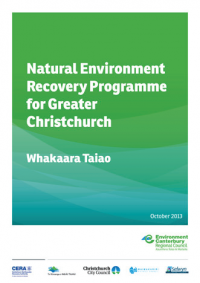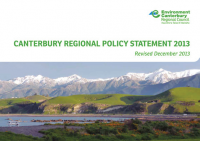
The development of the Natural Environment Recovery Programme [PDF, 2.1 MB] (NERP) was led by Environment Canterbury and was one of the recovery programmes identified within the Recovery Strategy for Greater Christchurch - Mahere Haumanutanga o Waitaha.
The purpose of the recovery programme was to repair and restore the natural environment and protect it from further damage during the rebuild.
It is also concerned with increasing the resilience of the natural environment to future events and processes.
It considers the effects of natural hazards and other environmental factors, including the effects of climate change and sea-level rise.
 The Canterbury Water Management Strategy
The Canterbury Water Management Strategy
The Canterbury Water Management Strategy [PDF, 2.7 MB] established ten water Zone Committees in Canterbury, which work with the Regional Committee to achieve the outcomes of the Strategy.
Each of the zones has completed Zone Implementation Programmes, which were endorsed by the Environment Canterbury Commissioners. The three Zone Committees in the Greater Christchurch area are:
Christchurch-West Melton
The Christchurch-West Melton Zone Committee(external link) operates as a joint committee of Christchurch City Council, Selwyn District Council, and Environment Canterbury. The Christchurch-West Melton Zone Committee developed a Zone Implementation Programme which focuses on the following five priority areas for water management:
- enhancing and managing waterways for recreation, relaxation and amenity
- improving surface water quality and safeguarding surface water flows
- enhancing healthy ecosystems, indigenous biodiversity and valued introduced species and landscapes
- safeguarding groundwater quality and flows for multiple uses
- Making efficient use of water and managing demand
Selwyn-Waihora
The Selwyn-Waihora Zone Committee(external link) operates as a joint committee of Christchurch City Council, Selwyn District Council and Environment Canterbury.
The Selwyn-Waihora Zone Committee took a 'whole of waterways' (similar to the 'Ki Uta Ki Tai' concept) approach to developing the Zone Implementation Programme.
The Zone Implementation Programme includes a catchment-wide view of land use and water quality, nutrient management, potential water storage options, and farm management systems to achieve the desired outcomes stated by the community.
Waimakariri
The Waimakariri Zone Committee(external link) operates as a joint committee of Waimakariri District Council and Environment Canterbury.
The Waimakariri Zone Implementation Programme includes 56 recommendations to Environment Canterbury and Waimakariri District Council, and other parties. The recommendations focus on biodiversity, land use and water quality.
The recommendations will be given effect to through council plans and work programmes.
Canterbury Water Immediate Steps Fund
A five-year $10 million 'Immediate Steps' biodiversity protection and restoration programme was launched in 2010 as part of the Canterbury Water Management Strategy. Three flagship projects were identified to support over the five years from 2010. These were Te Waihora/Lake Ellesmere, enhancement of the upper catchments of the Rakaia and Rangitata rivers; and the Wainono Lagoon project. Over 220 projects received funding throughout the Canterbury region.
Environment Canterbury Biodiversity Fund
The Environment Canterbury Biodiversity Fund has approximately $400,000 per year to support on-the-ground actions to protect and restore the region's biodiversity.
Mahinga Kai Exemplar Project
Te Rūnanga o Ngāi Tahu are currently working with Ngāi Tūāhuriri, the Avon Ōtākaro Network and the Canterbury Waterways Research Centre to develop an exemplar project. The exemplar project will provide for the protection and enhancement of Mahinga Kai values at a site on the Avon/Ōtākaro.
Edible Canterbury
A food resilience hui was held at the University of Canterbury in 2013, co-hosted by Soil and Health Canterbury and the Rangiora Earthquake Express. From this hui, a Food Resilience Network was formed and Edible Canterbury was established in 2014. Edible Canterbury is a multi-agency group which aims to examine issues around food security and availability in Canterbury from a range of perspectives. Edible Canterbury is committed to increasing the availability of good food to the residents of Greater Christchurch.
Regional approach to risk
Environment Canterbury is working with Civil Defence Emergency Management and territorial authorities to develop a regional approach to managing natural hazard risk. In 2016 an initial one-year work programme was developed, which will provide the basis for a long-term programme.
Regional Policy Statement (2013) Natural Hazards Chapter
 The Canterbury Regional Policy Statement (CRPS) became operative in 2013. Chapter 11 of the CRPS addresses natural hazards and reflects Civil Defence Emergency Management planning through the integration of hazard risk management and the natural and physical resource management regime in Canterbury.
The Canterbury Regional Policy Statement (CRPS) became operative in 2013. Chapter 11 of the CRPS addresses natural hazards and reflects Civil Defence Emergency Management planning through the integration of hazard risk management and the natural and physical resource management regime in Canterbury.
Objectives of the chapter are:
- to avoid new subdivision, use and development of land that increases risks associated with natural hazards
- adverse effects from hazard mitigation are avoided or mitigated
- effective integration of the management of and preparedness for natural hazards
Ōtautahi Christchurch Climate Resilience Strategy
The Ōtautahi Christchurch Climate Resilience Strategy(external link) is a blueprint for collective action and part of a wider conversation about how we work together to reduce our greenhouse gas emissions.
Waste and Environmental Management Team (WEMT)
Environment Canterbury, Christchurch City Council, Selwyn and Waimakariri District Councils and the now-disestablished Canterbury Earthquake Recovery Authority (CERA), established the Waste and Environmental Management Team, to monitor and manage compliance related to earthquake waste and contaminated land.
